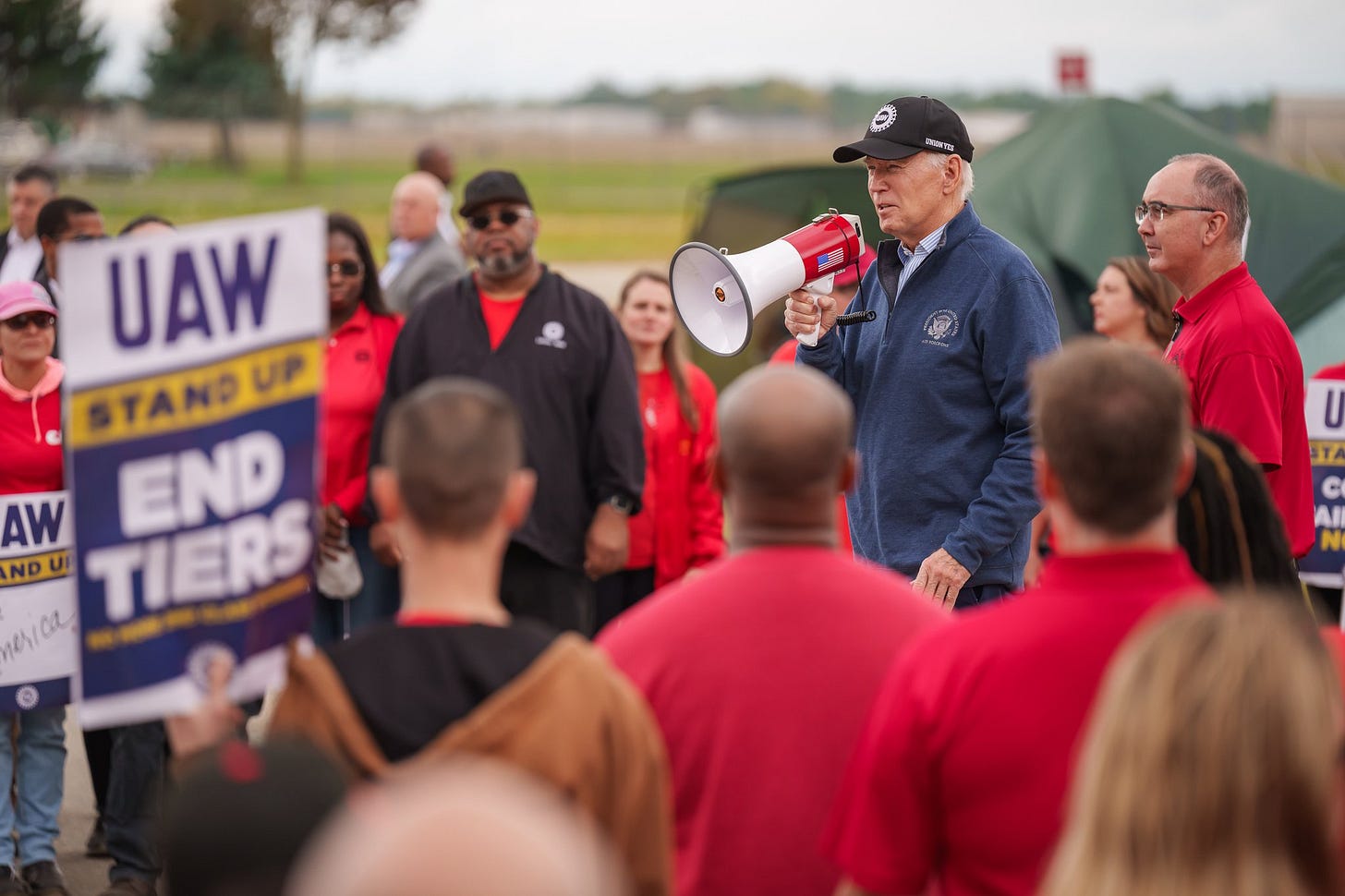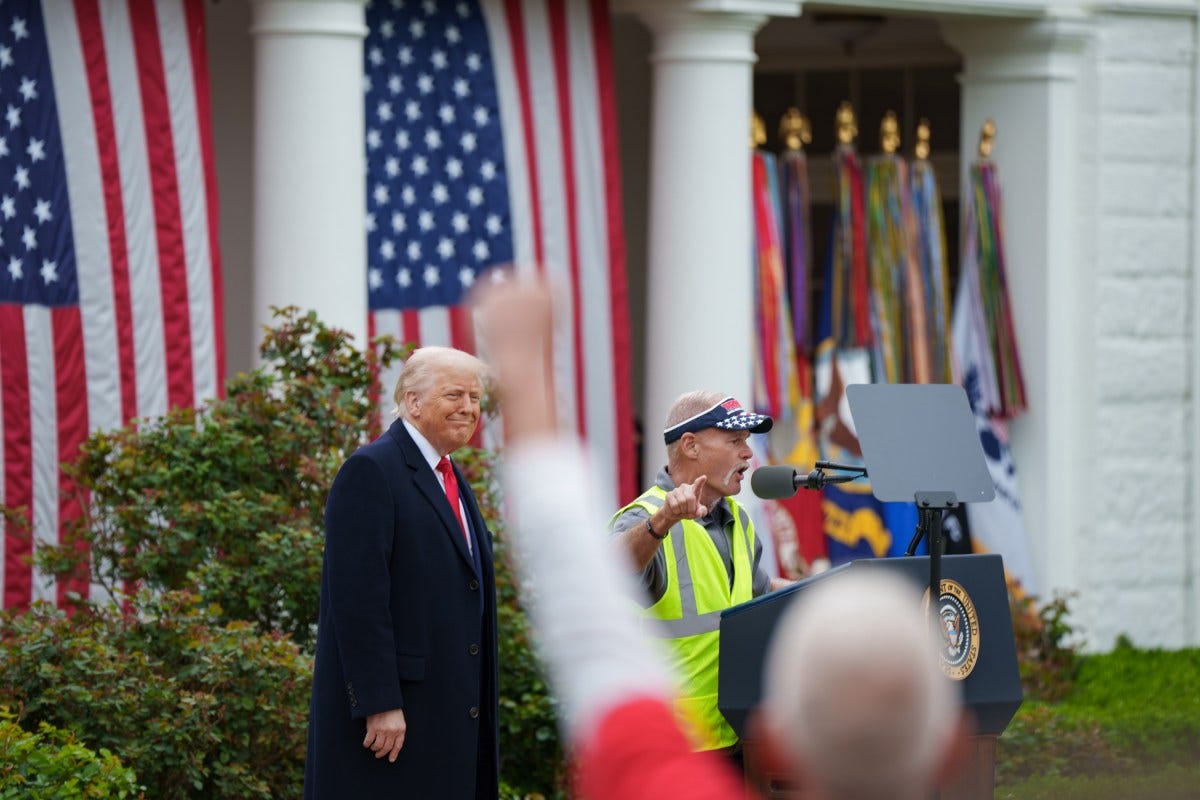The New Union Mov—and Its Old Costs
Gabriel Russ-Nachamie: The return of the unions and the possible trade-offs.
Interest in labor unions in the United States is experiencing a notable resurgence after decades of decline. Politicians and commentators across the aisle emphasize the importance of unions for improving workers’ economic well-being and reducing income inequality. For example, President Biden, who describes himself as the “most pro-union president in American history,” was the first president to walk a picket line. Additionally, J.D. Vance and, to a lesser extent, President Trump have been outspoken about their support for certain labor unions, reflecting a broader shift among Republicans toward appealing to working-class voters. Despite this renewed attention, the private sector unionization rate remains low at just 6% in 2023.

Economists have become increasingly concerned about workers’ lack of bargaining power and the presence of monopsony power in the labor market. A monopsony is traditionally defined as a firm that is the only buyer of labor. However, any firm with an upward-sloping labor supply curve is considered a monopsony in economics, even if the firm faces competition. If a firm faces an upward-sloping labor supply curve, it must raise wages to recruit new employees and to retain current employees. Because this situation makes the next hire costlier than the posted wage rate, the firm hires fewer people and pays less than it would in a competitive labor market.
In this non-competitive labor market, firms can artificially maintain low wages and employment levels because workers have no real alternatives. Even in today’s economy, where multiple small businesses and large companies often compete for labor in the same city, monopsony power can still exist. For instance, the high costs that workers face—e.g., losing employer-provided health insurance—when changing jobs can give firms a degree of labor market power.
Labor unions can alleviate this non-competitive labor market by increasing workers’ bargaining power against these employers. By allowing workers to negotiate as a group, a union can collectively bargain for a higher wage, one closer to the market rate in a competitive market, which can lead to increased employment and higher wages for workers. If the wage rate is pushed beyond the market rate, though, employment can fall.
However, while unions today still strive to obtain higher pay for their workers, which can theoretically increase efficiency where firms have some market power, the reality is that most labor unions today act as rent seekers. Unions primarily advocate for policies at the national level that benefit their members at the expense of all Americans. Overall, the economic costs of rent-seeking behavior by unions likely outweigh any benefits from the efficiency gains that some unions achieve by eroding monopsony power. In fact, many unions likely drive up wages beyond the competitive level, which lowers employment in the sectors and eliminates the benefits of challenging monopsony power.
Two examples of union rent-seeking behavior are the large $90 billion bailout for private sector unions under the Biden administration, which primarily benefited union members earning six figures, and the tariffs implemented by the Trump administration to protect unions while increasing costs on American businesses and consumers. The $90 billion spent on bailing out union pension funds under Biden could have almost covered the full cost of SNAP (food stamps) for an entire year for poor families.

Unions can also create significant economic inefficiencies. For example, unions often create barriers to entry for new workers, particularly in heavily unionized industries, which limits employment opportunities for job seekers who are often members of the lower or middle class. Furthermore, unions often resist technological changes that benefit Americans if these changes threaten their interests. For instance, unions frequently oppose port automation, which would enhance the resilience of U.S. supply chains. We should not consider policies that benefit only 6% of the workforce, who are private sector union members, “pro-worker,” when the policies harm the other 94% of American workers.
Public sector unions can also impose significant costs on the public. Research indicates that when school districts receive additional funding during collective bargaining with teacher unions, they tend to increase the compensation of existing teachers rather than hiring new ones, resulting in no improvements in student achievement. This negative effect happens because funding is tied to the tenure of teachers rather than merit. Teachers then lose the incentive to improve teaching and outcomes for their students.
Moreover, teacher unions enforce some of the strictest protections against firing, even if it means children are taught by someone incompetent. Most notoriously, in New York, these protections were so strict that schools opted to just remove incompetent teachers from the classroom, still technically employing them and paying their full salary. Such effects can also be seen in police unions, where a study found that police unions increase violent misconduct among officers because they make it more difficult to fire officers who engage in such misconduct.
Labor unions are not the only way to give workers more bargaining power and help those in need. Maintaining macroeconomic stability and tight labor markets with an adequately expansionary monetary policy increases firms’ demand for labor, leading them to bid up wages. Additionally, increasing access to education for workers, whether through technical school or a college education, equips them with skills that enable greater flexibility in their employment options.
The government can also directly increase the incomes of American families in need by modifying existing federal programs. For example, making the Child Tax Credit refundable and sent as monthly payments can support poor and middle-class families raising children. Additionally, they can expand the Earned Income Tax Credit (EITC) to increase the income of low-income Americans while increasing incentives to work. Decoupling health insurance from employment and making coverage portable would give workers more flexibility in changing jobs, thereby eroding the monopsony power of employers. The federal government, along with states and localities, can also eliminate policies that increase costs for goods and services, like tariffs and restrictions on building more housing.
Private sector unions can play a crucial role in enhancing the bargaining power of American workers, particularly when they voluntarily join to address common workplace concerns. However, unions are not the only solution to improving workers’ economic conditions and can come with significant costs. Addressing monopsony power, implementing an effective monetary policy, and increasing incomes through programs such as the Child Tax Credit and the Earned Income Tax Credit can significantly enhance workers’ well-being. Focusing on a comprehensive approach that includes these strategies can make the American Dream more attainable for everyone.

